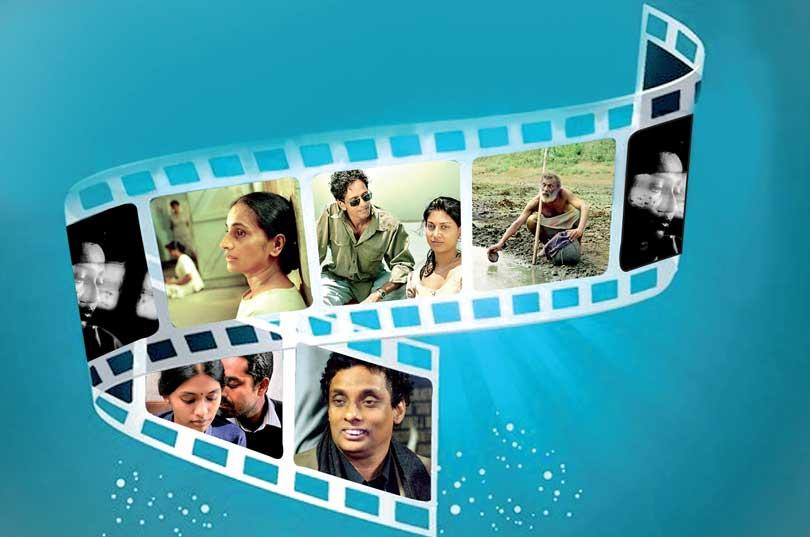Reply To:
Name - Reply Comment

 Somewhere between Sisila Gini Gani in 1992 and Ira Madiyama in 2005, I grew up. The Premadasa government fell, Chandrika Kumaratunga was sworn in as the new president, and the war, which she had made an integral part of her manifesto, was soon to accelerate. It was an unpredictable decade, certainly less gruesome than the 1980s, but no less uncertain. People were in no mood to go out to the movies, as evidenced by the rapid fall in audience numbers, and the eventual privatisation of the cinema, enforced against the advice of industry experts, worsened the descent. Against the most unpromising circumstances and obstacles, however, a new generation of filmmakers, many of them fresh out of university, ventured into the cinema and weaved stories centering on the war. This generation was different to that which preceded it, epitomised by Lester Peries and Dharmasena Pathiraja, but nevertheless they went back to, and freely borrowed if not reconfigured, the tropes of these auteurs.
Somewhere between Sisila Gini Gani in 1992 and Ira Madiyama in 2005, I grew up. The Premadasa government fell, Chandrika Kumaratunga was sworn in as the new president, and the war, which she had made an integral part of her manifesto, was soon to accelerate. It was an unpredictable decade, certainly less gruesome than the 1980s, but no less uncertain. People were in no mood to go out to the movies, as evidenced by the rapid fall in audience numbers, and the eventual privatisation of the cinema, enforced against the advice of industry experts, worsened the descent. Against the most unpromising circumstances and obstacles, however, a new generation of filmmakers, many of them fresh out of university, ventured into the cinema and weaved stories centering on the war. This generation was different to that which preceded it, epitomised by Lester Peries and Dharmasena Pathiraja, but nevertheless they went back to, and freely borrowed if not reconfigured, the tropes of these auteurs.
Lester’s revolution – liberating the cinema from the bonds of the South Indian melodrama – had been made possible on one hand by colleagues whose Western education endeared them to the European and, to a lesser extent, American cinema, and on the other by the growth of a bilingual middle class who read Regi Siriwardena and were receptive to the Western cinema. At the same time, it gave rise to a generation of directors who, in film after film, followed variations of the same plot lines and the same settings. The compilers of the 1990s editions of Insight Guide Sri Lanka were no doubt in error when they noted that Kurulubedda – “a film clearly stimulated by the innovations of Rekava”, as Regi noted – was directed by Lester, but the mistake was, if not justifiable, then at least understandable: the tide of Sinhala nationalism was so overwhelming that it was no longer possible to distinguish between Lester’s films and the films of those other popular (populist?) directors and producers.

All that popular audiences would have seen in Rekava may have been its depiction of a locale and milieu which gained ground after 1956: the village and the rural petty bourgeoisie. It was this trend the rebel directors of the 1970s reacted against: when, at the inaugural screening of Pathiraja’s Ahas Gawwa, copies of the pamphlet Appochchige Cinemawa were distributed, these rebels targeted their vitriol less at Peries than at the wave of romanticism and idealism that he had unleashed. He wasn’t entirely blameless there – till his last work, Lester remained a romantic and an idealist in his depictions of social relations – but as I’ve mentioned before, while they begrudged him for it, they could never be like him. Only Pathiraja could be his ideological foe, yet Pathiraja’s movies, being their own standard, never bred a following: the 1970s emancipated a middlebrow audience that rallied around Vasantha Obeyesekere, H. D. Premaratne, and other meda mawatha directors instead.
Thus if Obeyesekere, Premaratne, and Sumitra Peries had to work in the most difficult and discouraging circumstances a Sri Lankan director could work in, they had to account for the growth of a middlebrow audience whose tastes shaped the standards of not just movies, but also plays and television dramas. Vinod Moonesinghe tells me of a film industry official who, facing several producers, asked them what they wanted. Their reply was one word: “pight.” The linguistic gaffe notwithstanding, the encounter took place in around 1972, when Gamini Fonseka was enthralling moviegoers with one “pight” film after another.
The situation was no different in the 80s, but audience expectations had shifted. When Singer sponsored Dynasty, and people tuned into the Carringtons fighting over their oil fortunes, audiences began to demand a “family product” from local directors. Nalan Mendis, then just beginning his career, felt the need and filled the gap; if Lester Peries’s Awaragira feels like a redaction of Doo Daruwo today, it’s because Doo Daruwo was a symbol of its time and most movies and serials followed the trend it set by revolving around the Sinhala family. Then the bheeshanaya came, keeping the film going public away and completing a descent that began in 1983 with the burning of theatres and studios. The embourgeoisement of the film industry, against the backdrop of privatisation and uncertainty, was an inevitable consequence, and so the cinema, in contrast to what it had been in the mid 1970s, became quite de-radicalised. The 1980s didn’t or just couldn’t breed another Bambaru Avith: after Soldadu Unnahe, the radical cinema sizzled off, never to regain the heights to which it had once soared.
It was in this context that Prasanna Vithanage emerged. Like Peries and Pathiraja, Vithanage hailed from a middle class background: a cosmopolitan neighbourhood in Panadura where, despite a preponderance of Buddhists, he’d hear prayers and hymns from the homes of his Catholic neighbours. Prasanna’s childhood encounters – with not just the arts but also people, “the most integral part of my work” as he has frequently stated – were formative influences on him. A voracious reader, and by all accounts a prodigy, he would declare his intention to become a writer at the age of eight to his mother. His interests soon swerved to the theatre. At his second school, Cyril Jansz College, he’d direct plays to raise funds, which he did at his third school, D. S. Senanayake College, as well. Meanwhile, having auditioned for a part in Titus Thotawatte’s Handaya and failed, he was offered the role of a production assistant: “It was there that my interest in movies began.” Introspective and contemplative by nature, as he still is, Vithanage was never the outgoing type: as a friend of his father would recall decades later, “he always carried a book, even to a soccer match.”
One Bernard Shaw – Avi, based on Arms and the Man – and one Dario Fo – Debiddo, based on Raspberries and Trumpets – adaptation later, he toyed with the idea of making a film. The result, in 1992, was Sisila Gini Gani, which like Rekava and Ahas Gawwa has the exuberance of a sincerely felt debut. If the film didn’t exactly herald the beginning of a new era, it at least shored up Vithanage. It contained none of the roughnesses of Rekava and Ahas Gawwa, and although Vithanage’s handling of the subject matter seemed a little theatrical – in particular, the virindu sequence in which we are told in musical form of the dilemmas of the characters, something we’d already figured out from the foregoing sequences – it indicated that this was a director to reckon with, bringing to the fore his overriding concern, which he would revisit in later work: in his own words, to make us “examine ourselves.”
If Peries was influenced by the humanism of Jean Renoir, and Pathiraja by Beckett and the East Europeans, Prasanna was shaped by a more eclectic cinematic palate: Ingmar Bergman, Yasujiro Ozu, Abbas Kiarostami, Krzysztof Kieślowski. Tempered by the harrowing prospect of war, conflict, and existential turmoil, the characters in the works of these auteurs turn into studies in humanity: Tomas, the fisherman in Bergman’s Winter Light, commits suicide after trying and failing to grapple with the threat of an all out nuclear war, while the protagonist of Kiarostami’s Taste of Cherry tries to get those he meets to bury him alive in the sand: “I don’t want to give you a gun to kill me. I’m giving you a spade.” Prasanna’s films don’t delve into extreme dilemmas of that sort, but his characters – there are no protagonists and antagonists among them – try to resolve themselves in the light of their pasts: “Is this journey I am taking a reality, or a fantasy? I can no longer tell them apart,” Suvisal in Anantha Rathriya informs us, adding, “I am like a wounded animal, returning to its cave.”
Here, literally transposed, are the two motifs which feature in Prasanna’s work: the character in search of the truth of an incident from the past (a rape in Anantha Rathriya, a rekindled but long lost romance in Pawuru Walalu, the fate of a son sent to war in Purahanda Kaluwara, that of a husband missing in action in Ira Madiyama), and the image of a wounded animal resolving that past by returning to its cave (the rapist’s confession in Anantha Rathriya, the consummation of romance in Pawuru Walalu, the digging up of the “coffin” in Purahanda Kaluwara, the convergence of the plotlines in Ira Madiyama). It must be said that in all these stories, except one, the past obtrudes on the character’s life: the exception, if one can call it that, is Ira Madiyama, where it is the characters who go out in search of the husband and his fate, and with it their past. Even there, however, and even in Oba Nathuwa Oba Ekka – and, I suspect, in Gaadi, which we’ll not be privileged to see for quite some time – the image of the characters, flawed and tempered by their circumstances as they are, forced to reckon with the past, holds: the centrepiece of the most assured filmmaker in Sri Lanka today. That he’s still at it, and hasn’t relented, is certainly cause for celebration.